Watervilla Monnickendam is finished
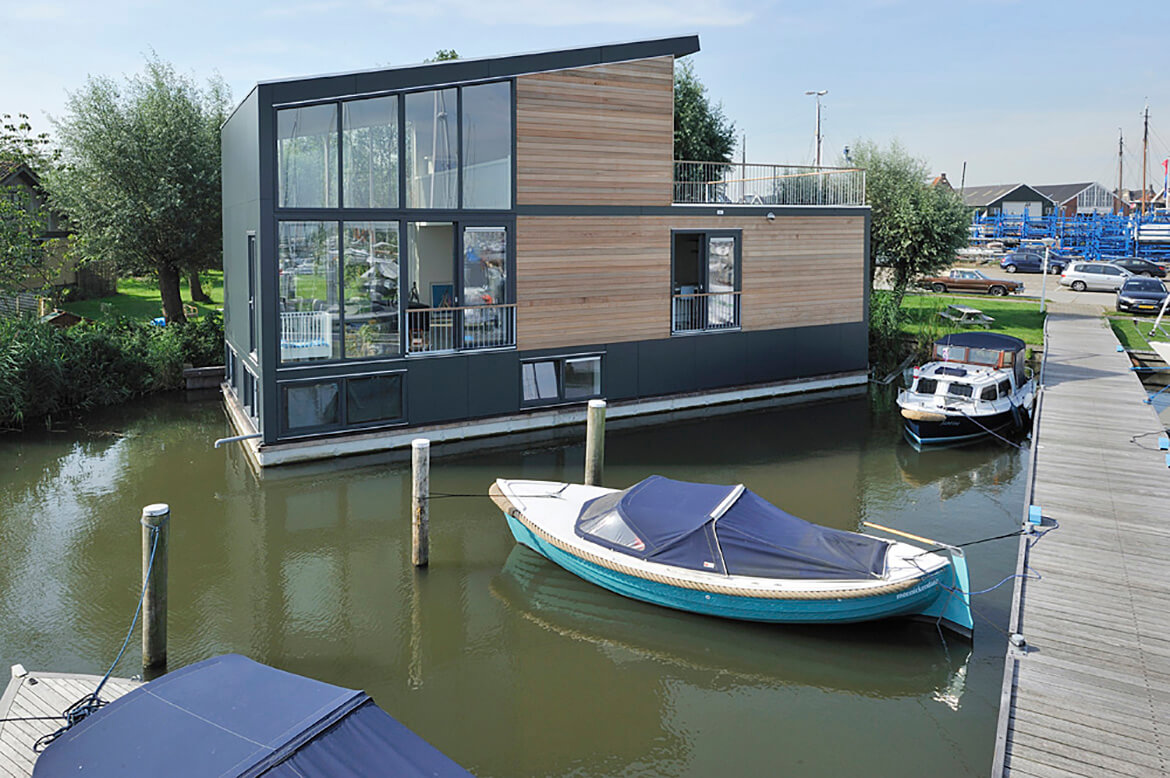
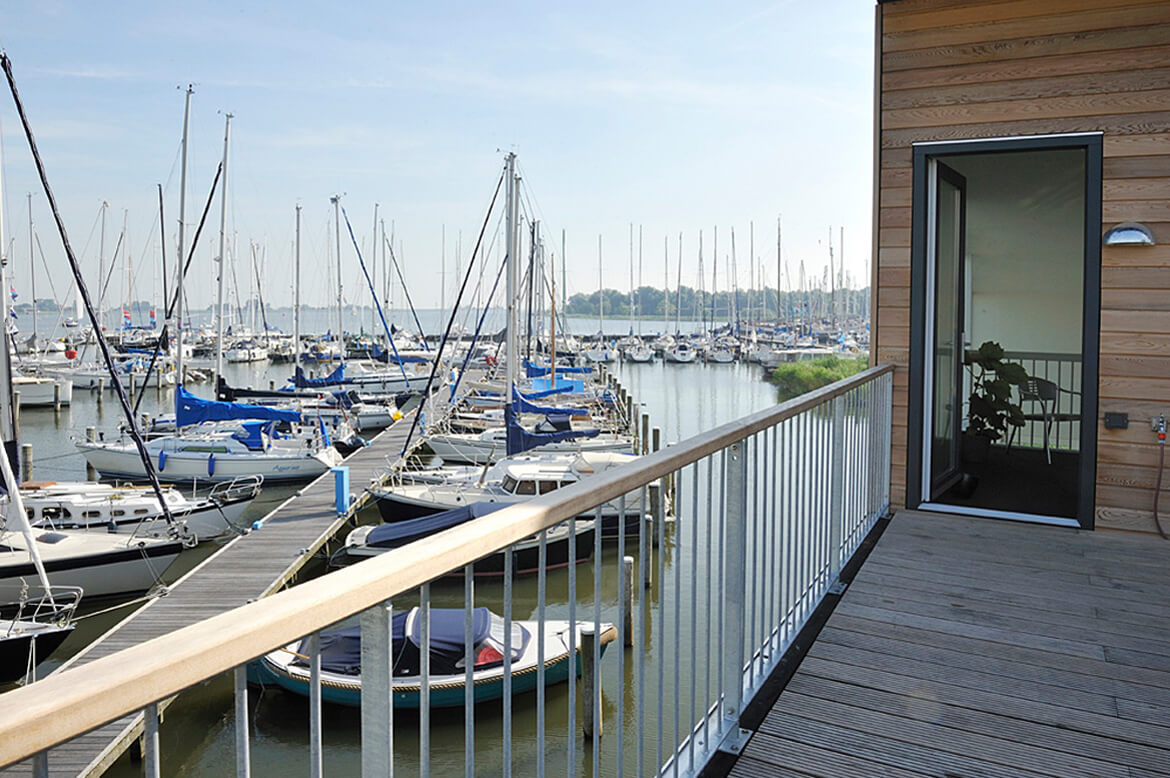
Watervilla Monnickendam is finished. The villa is located on a nice spot in the city’s marina.


Watervilla Monnickendam is finished. The villa is located on a nice spot in the city’s marina.
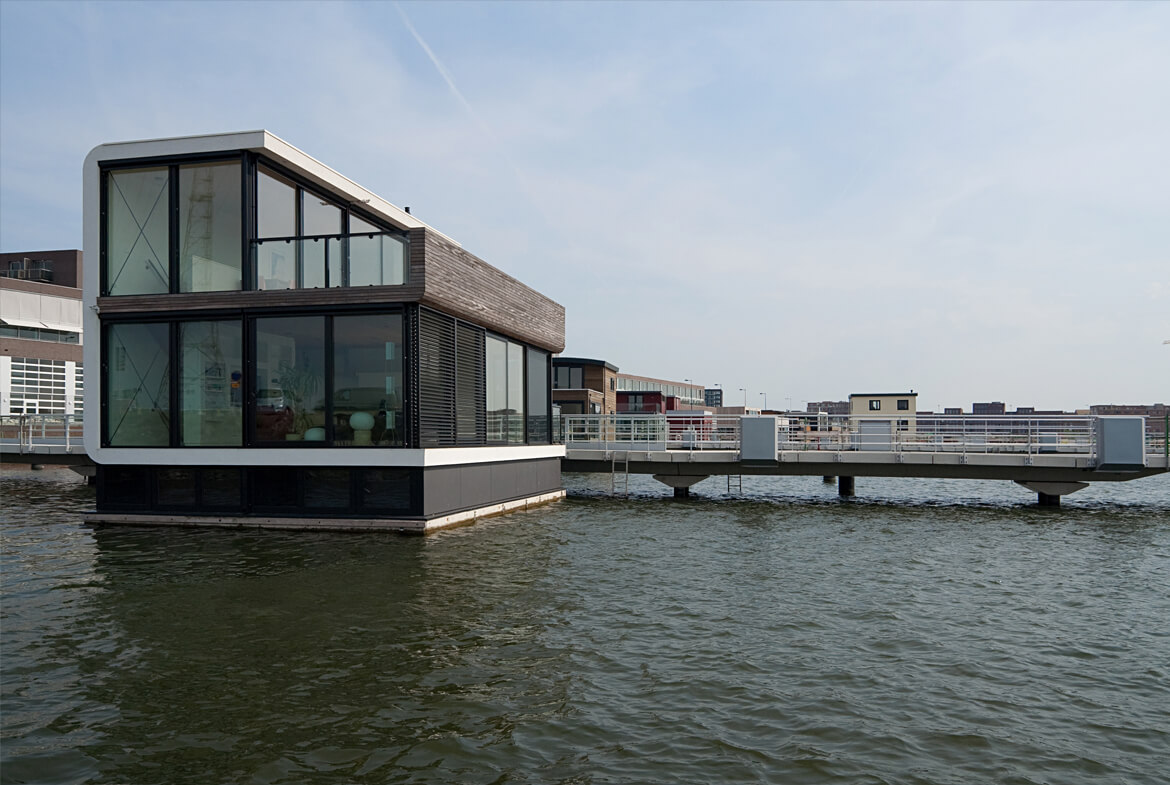
Archilovers, Jan 2014
This plan was designed for an urban water-development area in Amsterdam. Strict limitations of the building envelope and 2,5 storeys, while maximizing effective floor space for the principal, forced the designers to come up with a strong architectural principle that organized the dwelling with only modest means. The location at the end of the pier, where the view should be focused on the water while shielding off the dwelling from adjacent houses, provided the initial starting point. The architectural concept comprises of two basic shapes, filled in with glass panels. The main volume is enveloped by a white stucco slab that runs along the 1e storey floor, covers the entire back wall and roof, forming a continuous line that frames the living area and the open view. This simple yet elegant shape is complemented by a second shape in wood formed by the terrace floor and curving up to form the banister. Together, these two simple gestures define a distinct, almost iconic appearance. On the lower floor, which is partly below waterlevel, three bedrooms and the bathroom are situated. The ground floor is largely an open layout where only the toilet and some storage space separate the entrance area from the main space. Two large swinging doors can be used to close off the hallway.A neatly designed cupboard containing television is the only main element in the open space. Behind this, two stairs lead to the lower storey and to the working-area on the top floor. The ceiling of the living room is made in the same wood as the outside shape to really carry through the concept of the two curved shapes making up the dwelling. The top floor only occupies half the floor-surface, creating a wide terrace where again the wooden decking continues inside. When the large sliding doors are open, inside and outside space blend together.

Think Dutch, Robert Thiemann, Jeroen Junte & David Keuning, Dec 2013
Think Dutch! does not make any fundamental distinction between design and architecture. The book groups together the work of the young creative generation into 16 chapters with titles such as “Build on Water”, “Celebrate Food”, “Don’t Create for Eternity” or “Get Educated”. It poses thought-provoking questions such as: “Does this design yield new insight?”, “When does it make sense to use bio-degradable materials in architecture?” and “How can we establish self-sufficient food chains?” It is this critical approach to creative work that has become integral to Dutch architecture and design in recent decades.
This book presents 476 diverse architectural and design projects and products, devised by some of the most creative contemporary minds in this field; all provide positive proof of cutting-edge thinking, and investment in sustainable futures, exciting ideas that are inspirational, leading the way towards a brighter future.
Click here for the full article
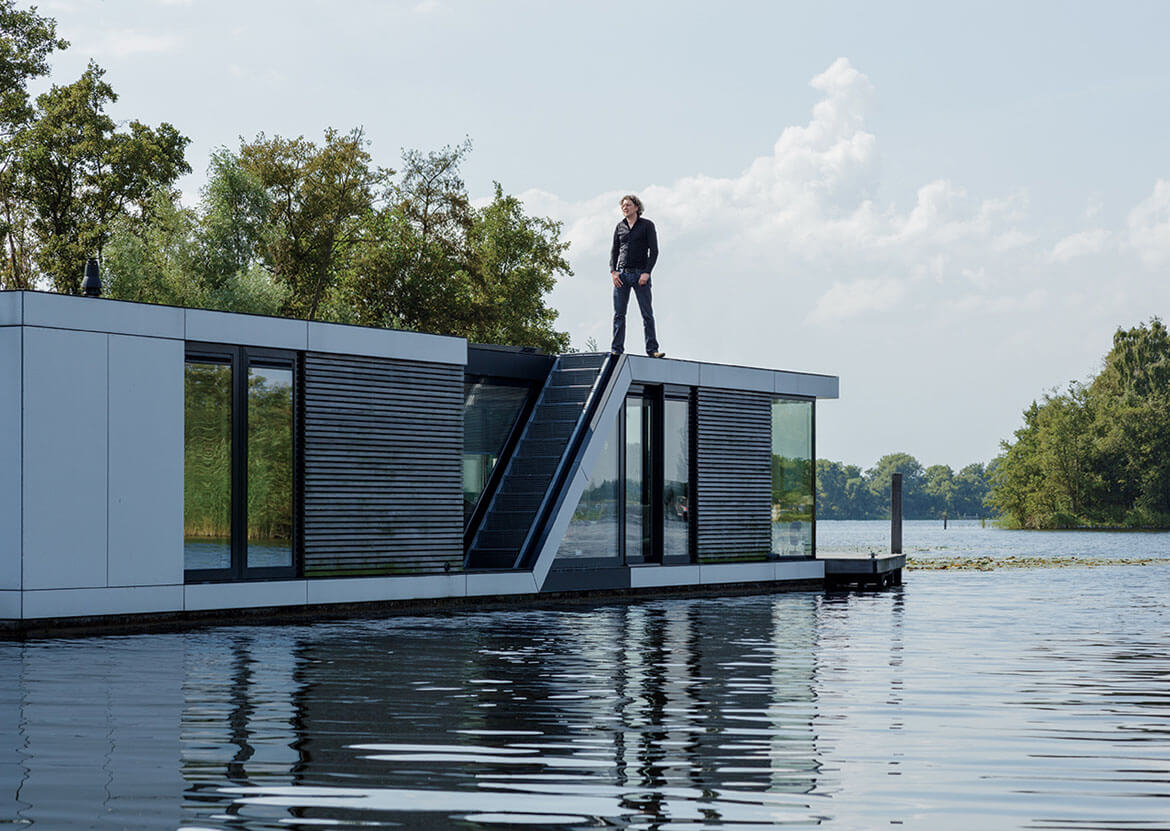
Fast Company, Jeff Chu, November 2013
For centuries, the Netherlands has suffered from catastrophic floods. As the rest of the world now reckons with the same fate, the Dutch are sharing–and selling–what they’ve learned.
Huib de Vriend was 5 years old when the great flood of 1953 hit. It was a chilly Saturday night, and the local radio stations had gone off the air at their usual hour near bedtime, just before the full force of the storm blew in. What shook young Huib more than the whistle of the wind or the thrum of the rain was the panic in his grandmother’s voice. “She was yelling: ‘The water is coming! The water is coming!’ ” he recalls. That was when he knew something was wrong. His grandmother was usually a voice of calm in the family.
They fled to the attic. Huib’s father ventured down to the ground floor, which had filled like a bathtub, to raid the pantry for provisions. A few days later, soldiers arrived in dinghies to help the de Vriends evacuate to their local church, which was built on the village’s highest ground; not long after, they were moved by rail to a town 10 miles away, where Huib attended kindergarten for several weeks before his family was allowed to return home. “Only later did I realize that my grandmother belonged to the generations with an inbred fear of water,” he says. “She never even learned to swim. It was not normal to swim. So you can imagine that even a meter of water was enough to make them nervous.”
The de Vriends survived, but more than 1,800 of their compatriots did not. Three hundred thousand Dutch were left homeless, and one-tenth of the nation’s farmland flooded. The famously pragmatic Queen Juliana, who had banned her subjects from bowing and curtseying to her, pulled on rubber boots to join the relief effort. “God,” she declared, “now calls upon our powers of resilience.”
In the Netherlands, that resilience ultimately meant far more than a season or two of furious rebuilding. De Vriend grew up to become a coastal and fluvial morphologist, a kind of scientist that studies the dynamics of shores and rivers. Though he insists the floodwaters did not set his career path, he acknowledges that “you don’t forget something like that.” (He also learned to swim.) He meanwhile became part of a growing army of engineers, designers, and scientists who since 1953 have made it their life’s mission to work with water, as the Netherlands built itself into the world’s premier laboratory for how to tame the rivers and the seas. Today, the country’s ideas and expertise may be its most valuable export. “Retreat is not an option, though we know it’s dangerous. The only option is to protect ourselves,” says Free University of Amsterdam professor Jeroen Aerts, the world’s foremost expert in flood-risk management. “If we invest right now in innovative measures, we can avoid a lot of damage in the future.”
Visitors who come to the Netherlands in the hopes of seeing a foolproof system of flood control that they can easily duplicate back in their home countries are bound to be disappointed. The Dutch have learned the hard way that no single solution will suffice. Their rebuilding efforts since 1953 have evolved away from post-disaster clichés–We’ll show the storm who’s boss!–to something far more sophisticated. What you see there now, especially what has been built in the past few years, is indeed the architecture of the future, as the fight against rising tides goes global. But it’s also the attitude of the future. The Dutch have lately been working with nature instead of battling it, lowering barriers against the water instead of raising them. They’re harnessing the power of the cloud–enormous amounts of data and cutting-edge computer modeling–to predict the consequences of the clouds. They’re building seawalls so beautiful you wouldn’t recognize them. And as I discovered, the most important lessons they are trying to impart might not be about dikes and dunes at all.
Nearly half of the world’s population lives within 60 miles of the sea, and hundreds of millions more reside in river valleys. In Hong Kong and Singapore, New York and Shanghai, thousands of acres of new waterfront land have been created through the magic buildup of landfill–and then stacked with luxury condos and gleaming office towers. Yet the risk of coastal living has grown in lockstep with that land’s soaring value. Seas are rising. And land is sinking. The soil under Jakarta, Indonesia, for instance, drained steadily of groundwater, is collapsing 4 inches a year.
As scientists predict a wetter, stormier future for much of the planet, the Dutch have become a nationwide consulting company, fanning across the world to talk about water. They are working on water-related projects from the Mississippi to the Mekong, and their thinking was a cornerstone of New York’s $20 billion post–Hurricane Sandy protection plan. “We are branding this knowledge around the globe, and we are benefiting from it,” says Piet Dircke, who is widely known as the “water guru” at the Amsterdam-based engineering-and-consulting firm Arcadis. “You don’t need too many Dutch,” he says, “but a few can help you a little bit!” Dircke is a jovial evangelist for better water management, who speaks of dikes with a passion usually reserved for football teams and refers to New Orleans’s revamped levees as “absolutely fabulous!” He spends about 200 days a year away from home, and his recent itinerary reflects the demand for Dutch help: Bangkok, Jakarta, Ho Chi Minh City, Dhaka, Shanghai, New York, New Orleans, Los Angeles, San Francisco.
When Dircke started at Arcadis 20 years ago, it was mainly a Dutch company–“95% of our business was Dutch,” he says. Last year, just 12% of the firm’s $3.35 billion in revenue came from the Netherlands; the U.S. was by far its largest market. Arcadis is working with the Army Corps of Engineers on wetlands rejuvenation in the Mississippi Delta. It is helping to restore the Los Angeles River’s natural flow. And it did hydrological-modeling work for the Bloomberg administration on Jamaica Bay in New York, hoping it will lead to more post-Sandy flood-protection business. “If I were a New Yorker, I would be very excited,” he says. “How fantastically interesting!”
And for the Dutch, how fantastically lucrative. It’s undeniable, says Matthijs van Ledden, an executive at the engineering firm Royal HaskoningDHV, that the surge in Dutch business is closely related to the surge of global disasters. After Katrina, van Ledden moved to New Orleans for four years to lead a team that helped the Army Corps strengthen the city’s levees. Governments fund most of the water business, but lately, Royal HaskoningDHV has seen strong growth in corporate spending, too. In Thailand the 2011 floods crippled factories of multinationals like Honda and Canon, stalling their supply chains. Today, they’re devising their own risk-reduction plans. “They could wait for the government,” van Ledden says. But in many locations they are choosing to move forward independently, and as fast as possible.
While these Dutch companies are competitors, they also collaborate. Arcadis, Royal HaskoningDHV, and a third major Dutch contractor, Boskalis, won business in Louisiana after teaming up with the Dutch government on a post-Katrina plan that offered the Army Corps ideas for rebuilding. They did the same for New York after Sandy last year. All three companies also belong to a research consortium that is testing new flood-protection solutions in the Netherlands. Meanwhile, five smaller engineering and design firms have banded to form an export-focused group called Dutch Water Design, which now has projects in Belgium, Brazil, and India.
Dutch ambitions go well beyond retrofitting. Architect Koen Olthuis’s atelier, Waterstudio.nl, does only water-based projects and has designed several floating houses in the Netherlands. Now, in the Maldives, he–in partnership with the developer Dutch Docklands–is building a resort, complete with an 18-hole golf course, that will float entirely on a Styrofoam-and-concrete foundation. He sees it as an early step into a wholly new market; eventually, he’d like to build floating housing for the poor in the Maldives and Bangladesh. “Building on water gives so much more freedom than land,” Olthuis says. “The next step is not going higher into the air, like 50 or 100 years ago. It’s going over the water.”
Such futuristic talk may reinforce the Netherlands’s reputation as a magical nation of water whisperers, a notion that van Ledden finds laughable. When he lived in New Orleans, he says, some people spoke to him as if he were some sort of Dutch saint. “People look at you as if, when you touch something, everything will become dry. But we need to be honest. It took us about 10 centuries to come to the conclusion that we needed to develop a long-term strategy, because short-term measures did not work.” Indeed, his homeland suffered gravely to get all this expertise–and all this business.
here are 16 million Dutch crammed onto a piece of waterlogged land that, if it were part of the U.S., would be one of the smallest states. “Everyone sees the Netherlands as a place with people who know how to deal with all this,” says Taco Kuijers, a designer at the urban-design firm Posad. “But we’re not geniuses. We’ve just learned a lot from our mistakes. And we’ve learned slowly.”
If you praise the Dutch for being “ahead” in flood protection, you must also acknowledge that they have been “ahead” in waterborne woe. They’ve been losing lives to floods long before the 20th century–the killed as many as 10,000 people and destroyed hundreds of thousands of homes. Perversely, St. Elizabeth is the patron saint of widows, dying children, and the homeless.
Still, it was the 1953 flood–a Netherlandish Katrina–that truly mobilized the country. It inspired unprecedented investment in a massive, multidecade project, known as the Deltaworks, to fortify the coast. Traditional dike-building materials–clay, sand, fear–were replaced by steel, concrete, and confidence in modern engineering. Rotterdam got a new guardian angel, the Maeslantkering, which looks like a giant drawbridge toppled sideways into the water. Thousands of tourists visit each year to marvel at its wings–gates, each as wide as the Eiffel Tower is tall, that swing shut to protect Europe’s largest port. The Deltaworks effort also led to the 5.6-mile-long, $3.5 billion Oosterscheldekering, completed in 1986, which forms the world’s largest storm-surge barrier. A monument at one end captures the Dutch sense of conquest-by-construction: hier gaan over het tij de maan de wind en wij–“Here the tide is ruled by the wind, the moon, and us.”
Huib de Vriend, as an academic at the think tank Delft Hydraulics, built models predicting how water would flow through and past the Oosterscheldekering. He also tracked how the barrier disrupted the flow of sand needed to replenish tidal shoals and beaches that naturally help to slow waves and soften storms. He says, in professor-speak, that the shoals “evolved negatively” because of the Oosterscheldekering. In laymen’s terms, they shrank because they didn’t get enough sand.
Dutch law compels the government to maintain the coastline at 1990 levels. This is politically sensible and ecologically stupid–a waterfront home may seem permanent, but shorelines shift. This strategy, which keeps the beach a half-mile wide in places, requires a costly annual deposit of 1 million cubic meters of sand. Which compelled a group of scientists including de Vriend and his Delft colleague Marcel Stive to solve an interesting puzzle: Can nature be harnessed to help do this unnatural thing?
Two years ago, the Sand Engine was born. Twenty million cubic meters of sand were mounded to form a half-mile-wide, 1.25-mile-long beach extension. Hydrologists and engineers had calculated that currents would eventually move 60% of the sand northward, 40% south. “Look what happens if you build a sand castle at the edge of the surf and the tide comes in,” says Stive. “You see the wave diffuse around it. The sand is not gone. It just spreads in all directions. If a sand castle disappears in half an hour, the Sand Engine is supposed to last 20 years.”
The Sand Engine, which is shaped roughly like a stiletto stepping onto the existing shoreline, does mostly what its designers expected: It buffers a vulnerable coast while delivering recreational and ecological benefits. The lagoon created by the “heel” has become a popular kite-surfing venue as well as an important habitat for juvenile flatfish. Flocks of gulls loll on the sand. Sea grass has taken root, dotting the white expanse with green. The sand has traveled roughly according to plan. Already, local governments in France and England have initiated projects mimicking the Dutch design.
This might be premature: The Sand Engine team also expects surprises. “All models are built with inputs, a system, and outputs. But what if you don’t know how the inputs will vary?” says de Vriend, who is now 66. Usually he has a gentle, grandfatherly mien and thinks for a few beats before speaking. But as we stand on an escarpment carved by the waves since his last visit to the Sand Engine, he seems like a giddy 4-year-old. “Isn’t this fantastic?” he tells me. “The dynamics are always changing, and it’s very challenging to understand. Models are never more than what we already know.”
Six miles north of the Sand Engine sits the district of Scheveningen, which has two distinct stretches of seafront. The northern section is chockablock with cheap souvenir stands and neon-lit bars. On the southern stretch, the sky feels bigger. Construction crews here are finishing a new, $100 million promenade that’s all bright and clean, bleached wood and powder-blue steel, as if the scene had been run through an Instagram filter called “New Dutch.”
There was no dike here before–it was one of the coast’s least-protected sections–and only the most knowing observer would notice the one there now. The rest of us would see an undulating waterfront park, sloping seaward from the dunes to a one-way street for cars, then to a bike path, then to a pedestrian area and beach. The largest project of architect Age Fluitman’s career, it is an artful demonstration of how to integrate traditional beachside amenities with sophisticated protections against future storms. “Making a dike here was quite extreme. You want something 10 or 12 meters high, and 30 meters wide–a big thing!” says Fluitman as we stroll the promenade. Dressed in a half-buttoned check shirt, cargo shorts, and flip-flops, he looks more like a beachgoer than a boardwalk builder. Originally, he explains, the government hired Spanish architect Manuel de Solà-Morales, who was renowned for rejuvenating Barcelona’s waterfront. Fluitman worked with Solà-Morales and took over after his boss died last year.
Building a multilayered dike hidden under a beachfront is not easy. Regulators decreed that no single object on this dike, which is designed to withstand a storm even stronger than the one in 1953, could weigh more than 700 kilograms; anything heavier could puncture the seawall mid-storm. Fluitman, lanky and athletic, lopes over to a pedestrian bridge linking the dike-top roadway with the pedestrian promenade. “It looks like steel, right? But it’s actually built of composites,” he says, beckoning me to join him underneath the bridge. Crouching, he points out the small nuts and bolts studding the ends of the beams, explaining that they’re calibrated to detach in a major storm surge. “This bridge can support 500 people. But what other bridge in the world is designed to fall apart into hundreds of pieces?” At one point during the planning process, he adds, one local official asked, “Can’t we plant some palm trees?” In response, Fluitman designed 36-foot-tall lampposts crowned with arms reaching in different directions–stylized palm trees. He smiles. “These fall apart too.”
Fluitman seems especially pleased by the contours of his promenade. He came to this beach as a boy and recalls it as straight and flat; given the chance to redesign it as an adult (he’s 36), he created horizontal and vertical curves to increase visual drama. “See these gentle hills?” Fluitman says. “This makes you interested: What’s over there? What’s beyond that bend?” He discovered that Dutch regulators didn’t want a different beach. They rejected the curved proposal, arguing that straighter beaches make stronger barriers. But Fluitman asked for evidence. He suggested that rather than rely on conventional wisdom, they do some new modeling. And in the end, he was right: A curvy coast dissipates wave forces in a way that a straight seawall cannot.
The Dutch love data. Fluitman got his curves because of it. And a Dutch sense of caution has compelled everyone working in the field of flood control to collect and analyze immense amounts of it to make a watertight case. The government has mapped by air, to astonishing detail with laser and radar, the entirety of the nation’s topography. That information has inspired one of the most promising–and exportable–new innovations: 3Di, a cloud-based system that can simulate the effects of a rainstorm or a levee breach, storm surge or a water-main break. “The Netherlands is very conservative. We think we can solve everything with a bit of sand,” says Jan-Maarten Verbree, who heads IT at Nelen & Schuurmans, the water-focused consultancy behind 3Di. “But we say that with a bit of IT, you can increase safety even more.”
The computer system is based on the work of a professor at the Technical University of Delft. Wytze Schuurmans, Nelen & Schuurmans’s principal, says 3Di is 1,000 times faster–and can be accurate “more or less to the inch”–than any conventional flood models currently in use. In the Nelen & Schuurmans lab, a Spartan collection of desks located in a house in the medieval heart of Utrecht, Verbree and his colleague Olga Pleumeekers hover over an on-screen projection of the city of Delft. Pleumeekers decides to dump nearly 4 inches of rain on Delft in just one hour, “just to see.” This is not realistic, she tells me. “It’s a lot of water.”
She zooms in on a neighborhood between a key canal and Delft’s Cathedral. Within minutes, the floodwaters reveal the town’s topography–though the canal has spilled its banks, some canal-side streets remain dry while roads further inland are awash. Within three hours, water laps at the Cathedral’s apse, and as Pleumeekers zooms out for a regional view, a spreading quilt of blue reveals the extent of the storm. Any sane person would want to flee, but not northward–the model shows that the A4, the main artery to Amsterdam, is now underwater too.
The goal here goes beyond disaster planning for the Netherlands; the firm hopes to build a web-based version of 3Di that would allow a Manhattan building manager to simulate, say, a hurricane’s effect on his apartment tower. What 3Di most resembles is an aqua-centric version of SimCity–“but with realistic data and calculations,” says Verbree. When Pleumeekers switches to a machine holding data for Long Island–less detailed than what it has for the Netherlands, but sufficient to do basic simulations–I can see the potential.
What should we do, she asks? “Make it rain,” I reply. We center a cloud over an area on the edge of New York that was hard-hit by Superstorm Sandy and unleash 2.5 inches of rain. Within two hours, widening blue ribbons streak across the area. After five, the water has drained from the higher ground. Even after a day, low-lying coastal areas are still wet.
If you were to choose a person who best represents how Dutch thinking about water management has evolved over the past two decades, it might not be an engineer or architect at all. In fact, it might be Tracy Metz, who was appointed in 2007 to a national task force convened to propose ideas for the next 50 years of flood preparedness. Metz was, in her own words, “a representative of the people.” She was a journalist, with a typical awareness of the importance of water in the country’s past as well as in its policy making–an awareness reinforced by the 200-to-300-euro-per-person levy that every resident pays for local flood protection. But beyond her own story–born in Los Angeles, she moved to the Netherlands in the 1980s and jokes about growing up in a place with too little water, only to end up in one with too much–she says she was no water expert.
Over time, she became one. She learned that the dream of Holland as watertight fortress–canals are moats, straighter rivers are safer rivers, higher walls are better walls–is compelling but flawed. She discovered that the materials deployed in the Deltaworks, the country’s coastal bulwark, were sophisticated, but the methodology was essentially “the way they’ve done it from the Middle Ages.” Last year, she wrote Sweet & Salt: Water and the Dutch, the seminal book on Dutch water management. One of the book’s lessons is how Metz’s own education coincided with a shift in the official Dutch mind-set: They now accept that Mother Nature may be hard to tame but she seems willing to partner. “We used to defend against the water as our enemy,” Metz says. “You could say that there’s a new attitude: Water as our frenemy.”
This attitude has become as crucial to the Dutch as their technical sophistication–if not more so. And once again, floods helped bring about the change. In 1993 and 1995, as Deltaworks finally neared completion, floods hit the Dutch from behind. The Rhine, Meuse, and Waal rivers swelled with Alpine snowmelt, forcing 250,000 people from their homes. The decision was made to strengthen river defenses, but this time in a different way. For centuries, the Dutch had tried to channel rivers and streams into ever-narrower courses and canals. But gradually they came to realize that river systems were akin to greyhounds; you can try to confine them to small spaces, but they will always need room to run.
Hence, Room for the River, an initiative with 34 interconnected projects, including, most ambitiously, the digging of a new 2.5-mile channel in the city of Nijmegen that will alleviate the pressure at a particularly tricky bend in the river and create an island from what was a peninsula. In some places, dikes will be bolstered and raised. In others, they’ll be lowered, a radical, even heretical notion in a land where dikes have been piled ever higher for more than a millennium.
The largest dike to be lowered will be in the Noordwaard, an area in the southwestern Netherlands. For the past century, this area has been polder–wetland turned into fertile fields. Within the next two years, a 1.5-mile stretch of a 25-foot-tall dike will be lowered by 10 feet, creating new spillways for the New Merwede River. Nearly 8 square miles of fields once planted with potatoes and wheat will be “depolderized,” with large portions of the land flooding during times of high water.
Dikes are relatively easy to deconstruct. But entire livelihoods–especially those of a people who have, for centuries, clawed dry land from sea and swamp–are tougher. “This is a national safety project. But even with national aims, we have had to deal with personal interests,” says Hans Brouwer, a senior river expert with Rijkswaterstaat, the federal agency for flood protection. Fifteen farms were condemned, along with low-lying homes that will be threatened by the new spillways. “There were 75 families living in the Noordwaard. Forty will stay. It has been difficult. It has been painful.”
The government has done little to buy influence, refusing to pay above market for condemned properties. But neither has it deployed eminent domain. Vic Gremmer, a social worker who moved to the Noordwaard “to stay in nature,” says his payoff and the building subsidies offered by the authorities didn’t cover the costs of his new land and construction of his new house, down the road and up a small but significant rise from the old one. “We lived there for 21 years,” he says as we sip coffee in his new kitchen. He gazes out at his new patio and the new reed-edged canal beyond that. “We’ve got this new house, and these beautiful sights. But the old house, we were used to it–the keys go here, that goes there. Our children were born there.”
Perhaps the most innovative element of Room for the River is how officials built relationships with those whom the program will displace. Room for the River has project managers whose main job is to talk with residents. One whom I met was formerly a political lobbyist at EU headquarters in Brussels. He calls his current work “lobbying at the kitchen-table level.” The long-term approach in the Noordwaard has relied heavily on humility; officials repeatedly struck various compromises to help win residents’ support–or at least acquiescence. And slowly, through these conversations–15 years and counting–the officials helped Gremmer and most of his neighbors to understand the science behind the project as well as the necessity.
An effort like the depolderization–and more broadly, Room for the River–“is not only about engineering and design and technical innovation. It’s also about collaboration, a regional approach, and a mind-set,” says Henk Ovink, a former director-general at the Dutch Ministry of Infrastructure and the Environment, who has been exported to Washington, D.C., to serve as special adviser to Shaun Donovan, secretary of housing and urban development. “You can’t build a levee with a mind-set–you need money, you need ideas, and you need innovation. At the same time, you will never build those things if the mind-set isn’t right.”
Gremmer says there’s much to like about his new home. It sits 13 feet above sea level, so it’s unquestionably safer. He’s an avid birdwatcher, and a variety of species have been arriving in greater numbers. And if he’s hungry for fish, he just slides open the big glass doors to his patio and casts his line. The canal out back teems with eel, carp, and his favorite, snoekbaars–pike-perch. “Filet it,” he says. “Put it in a pan with a little bit of lemon, salt, pepper, butter. Delicious.”
“Are you happy here?” I ask.
He sighs a little before replying: “We’re not there yet.”
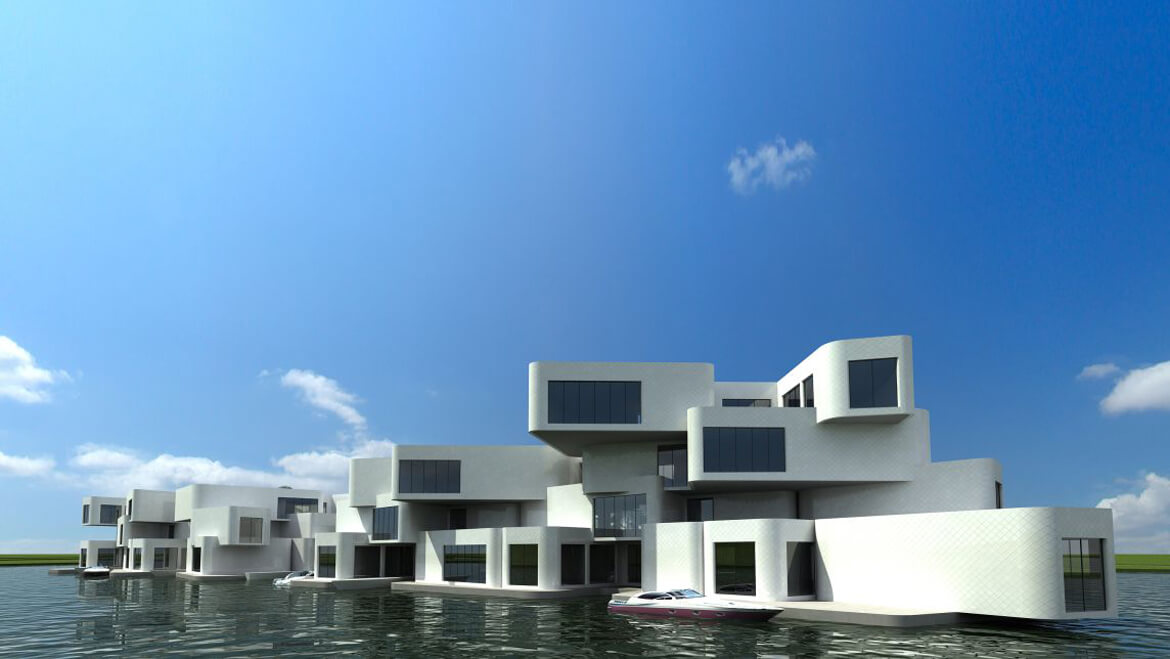
Gizmag, Phyllis Richardson, October 2013
 The Dutch are known for their ingenuity in taming it and using it to their advantage, but their systems for keeping water at bay are now being rethought by architect Koen Olthuis and his team at Waterstudio. While rising sea and river levels have inspired governments around the world to invest in better flood defenses, with the Citadel, Olthuis is embracing water-borne housing with particular vigor.
The Dutch are known for their ingenuity in taming it and using it to their advantage, but their systems for keeping water at bay are now being rethought by architect Koen Olthuis and his team at Waterstudio. While rising sea and river levels have inspired governments around the world to invest in better flood defenses, with the Citadel, Olthuis is embracing water-borne housing with particular vigor.
Designed for developer ONW/BNG GO, The Citadel is a flotilla of apartments in one modern luxury development. The project, which will begin building work early next year, will consist of 60 units in a high density arrangement (30 units per acre of water). Part of the project means halting some flood defenses and letting the water back in. Olthuis points out that Holland has as many as 3,500 polders (patches of low-lying land that are protected by artificial dikes) which are below sea level and kept dry by pumping water out 24/7. This new development, dubbed New Water, will essentially be re-flooded after centuries of being kept artificially dry.
Lightweight construction on top of a main deck and easy connections to land are part of the program designed to deliver the same level of comfort as in a high-rise building. A large, heavy, floating concrete caisson provides the foundation, which also contains the car park, and will support the apartments. These will consist of 180 modular elements, all arranged around a central courtyard.
Construction will take place in a temporary dry dock. When construction is completed, explains Olthuis, the pumps will stop and the site will flood. Once the site has been “depolderized,” the Citadel will float in 6 feet of water, which will later rise to 12 feet in depth. A floating bridge will connect the Citadel to the mainland, allowing residents and emergency vehicles access. The architects maintain that due to the large size of the overall concrete caisson base, which is 240 x 420 x 9 feet in size, residents will not be able to detect any water-related motion.
Though this is partly a government-funded enterprise, this is the higher-end part of the development and the design of the units is quite bold. The apartment blocks are made up of irregularly shaped floors stacked at odd angles to one another so that overhangs alternate with shaded window recesses. Each has its own floor plan and outdoor space.
Sustainability is an abiding concern, though the Citadel does not seem to have yet committed to the full range of technologies. The facades will be clad in aluminum, as its longevity and low-maintenance requirements were found to outweigh its energy costs. Greenhouse units and green roofs will be part of the environment but it is not yet clear how extensive these will be. Energy saving methods and technology are estimated to make consumption for the Citadel 25 percent less than that of a conventional building on land. Not surprisingly, all of the apartments will have water views and most will have their own berth for a small boat. The Citadel is part of a larger development that will be built in this depolderized zone of New Water, which will eventually have 6 such floating apartment buildings.

South China Morning Post,Jamie Carter, November 2013
There has been much debate on where land can be found to house a growing population in Hong Kong. For communities elsewhere, the need is even more pressing.
With global population density increasing and sea levels expected to rise by as much as 30cm by 2050, many coastal habitats will come under intense pressure. And the answer could be right on the horizon.
“In major cities there’s already a lack of space and the next logical step is to make use of water,” says Koen Olthuis, founder of Netherlands-based Waterstudio.nl and architect of multiple maritime projects.
“It’s just evolution – the elevator made vertical cities of skyscrapers possible, and water is the next step for letting cities grow and become more dense.”
More than two-thirds of the Netherlands is prone to flooding, and much of it is below sea-level, which gives its architects and engineers an unusual perspective on man’s relationship to water. While he stops short of proposing giant cities at sea, Olthuis thinks the definition of a city should be changing constantly.
Waterstudio.NL’s City Apps project tackles urban density and climate change. It was inspired by Olthuis’ belief that cities should be more flexible, and approached as a product.
“Smartphones all look the same but they are not, they are personalised with different apps,” he says. “We looked at cities and saw they have their own problems, and our floating City Apps simply add to the hardware of a city.”
Waterstudio’s first project is for the watery Korail slums of Dhaka, Bangladesh, where 70,000 people struggle to survive. Its solution – a small floating platform housing a school with 20 iPads fixed to the walls, intended to be used as an internet hub at night – has mostly been built in the Netherlands.
“In slums there are no rules – if you build a house it can be destroyed in a few months by the government rethinking that area, but if that happens then City Apps can be moved,” says Olthuis. “We’ve put the floating platform in Dhaka. We need 14,000 plastic PET bottles to keep one City App floating, so we got the local people to collect the bottles and paid them four to six cents each.”
The next City App – this time for sanitation – is planned for Bangkok.
A similar project comes from NLE, another Netherlands-based architectural practice, which has been working with the floating community of Makoko, near Lagos in Nigeria.
Around 100,000 people are thought to live here in stilt houses – largely as a result of massive urban sprawl – but the community lacks schools and infrastructure. NLE’s solution is a pyramid-shaped primary floating school built from local bamboo, which is intended as a community hub.
Such socially progressive projects are often spin-offs of lucrative contracts elsewhere. Waterstudio’s Five Lagoons Project, a joint-venture between Dutch Docklands and the government of the Maldives, will see an area of about 740 hectares supplied with luxury floating developments.
“We are going to develop five lagoons with different functions, including a resort, a conference hotel and a floating golf course,” says Olthuis, though the point of the star item – a luxury Ocean Flower resort of 185 villas – isn’t just to tempt tourists.
“By doing this we will learn how to make big green islands, and see how we can then make social housing on the water for local people,” says Olthuis.
His long-term goal is to help the 110,000 people in the Maldives’ capital city Malé, which is barely 1.5 metres above sea level and likely to be submerged in the next 85 years.
“You need this kind of expensive project to fund the future projects to help society,” Olthuis says.
Next up is Miami, where 17 floating developments will be built on a large lake. Floating communities aren’t always a response to rising sea levels in coastal communities. Non-profit organisation the Seasteading Institute wants to initiate an autonomous offshore community that pushes total freedom and encourages innovation and experimentation beyond the reach of governments.
“We’re looking for trailblazers,” says the organisation’s promotional video. “We believe humanity needs a new, blue frontier where we’re all free to explore new ways of living together.”
It claims “seasteaders” would only need the kind of money required to live in a big city. The institute is now attempting to raise money for its Floating City project on crowd-sourcing website Indiegogo, and doing fairly well – though it also needs a “host” country.
There’s a similar issue over at Freedom Ship International, a Florida-based company that is hoping to raise the US$11 billion needed to build the world’s largest vessel.
Designed as a mobile floating platform stretching over 1,600 metres, Freedom Ship – which could set sail renamed as the Global Friend Ship – is designed to host an entire city of up to 100,000.
Just under half that number will reside permanently on the ship, which will make its way slowly around the world’s coastal regions over three years.
As it moves, a fleet of ferries and small aircraft (there’s an airport on the roof) will take residents to shore – as tourists or businesspeople – and bring tourists onboard to visit the 2.7-million-tonne vessel’s casinos, restaurants and businesses. It will have schools, a hospital and a security force.
“It’s the first ever floating city,” says Roger Gooch, director and vice-president of Freedom Ship International, “but it’s too large to go into a port so it will also stay around 15 miles [24 kilometres] offshore in international waters.”
Freedom Ship is designed to let people get away from the normal restrictions of global geography and governments, he says.
There’s a similar reason behind another offshore entity called Blueseed. A purpose-built floating platform registered in the Bahamas but moored in international waters 22 kilometres from the shores of San Francisco, Blueseed is aimed at international entrepreneurs who can’t enter the US (Silicon Valley, in particular) to start companies because of restrictive visa issues.
Offering its occupants – all with a US business or travel visa – daily 30-minute ferry rides to the mainland as well as helicopter trips, Blueseed will begin life next year on a refitted cruise ship, progressing to the custom-built Blueseed Two floating city soon after.
But life at sea isn’t just restricted to land-based humans. Olthuis has a vision of a Sea Tree, a multi-storey floating structure similar to an oil rig that could be placed in rivers, lakes and oceans near densely populated cities.
“Instead of creating green areas in the city, make them on the water,” he says. “When nature starts to colonise a Sea Tree then birds, animals and insects will use it, too.”
Olthuis already has a way to pay for it. “I could see oil companies donating Sea Trees to cities in return for drilling rights,” he says.
A Sea Tree in Victoria Harbour? That really would give Hong Kong a new look.
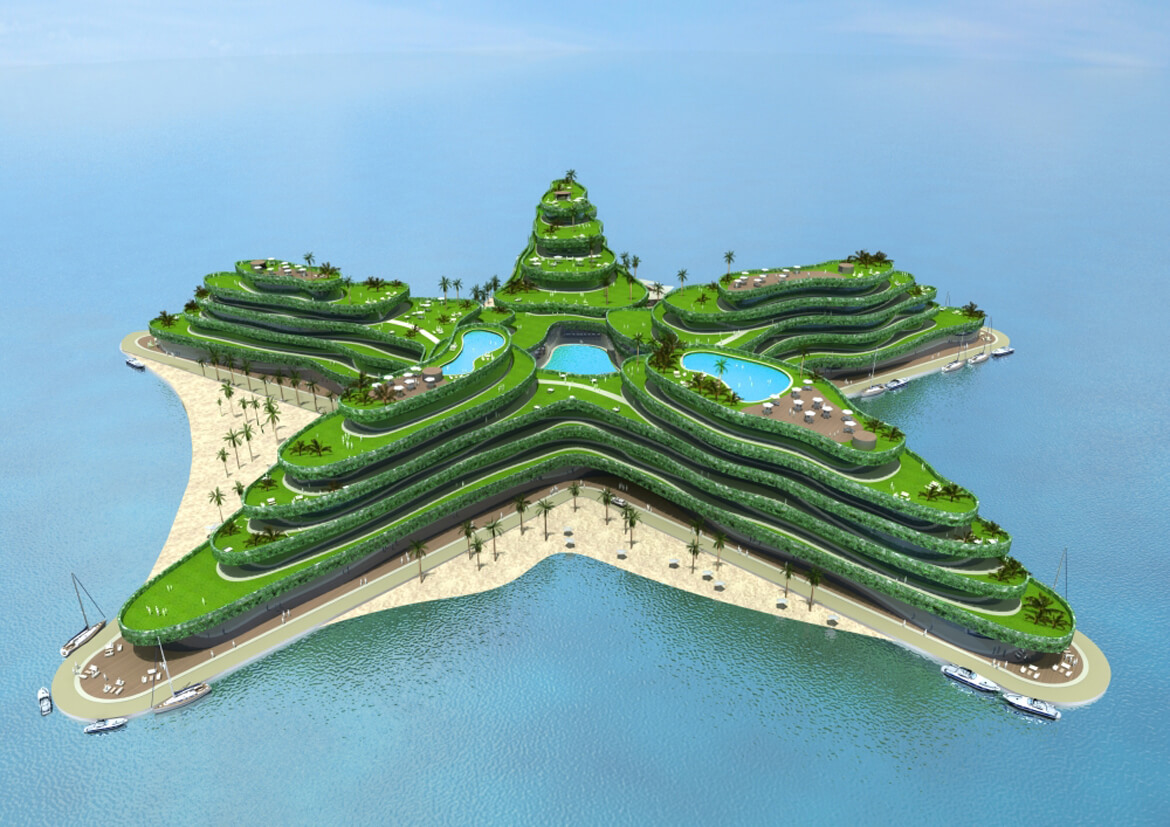
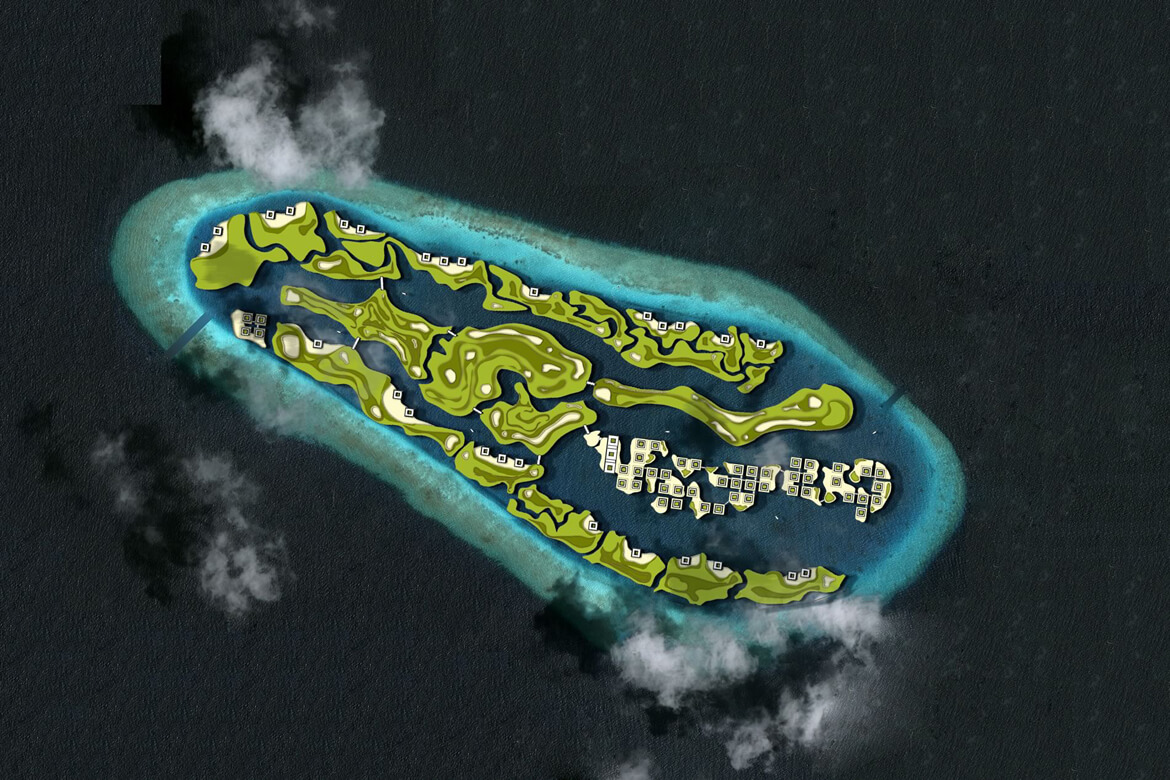

Marina World, March 2013
Nestled in the Indian Ocean between Minicoy Island and the Chagos Archipelago, the Maldives comprise a chain of 26 atolls made up of islands and reefs. Tropical weather, white sand and clear water make the islands a popular holiday destination and a haven for divers but, while the surrounding ocean teems with life, home to coral reefs, eels, sharks, turtles, dolphins, manta rays and over 1,100 other species of fish, rising sea levels pose serious threat. Charlotte Niemiec reports on an ambitious community and tourism project aimed at keeping the Maldives afloat.
The average ground level in the Maldives is just 1.5m and the island’s president, Mohammed Nasheed, has warned that even a ‘small rise’ in sea levels would eradicate large parts of the area. Envisioning a future for its people of “climate refugees living in tents for decades” the Maldivian Government has teamed up with Netherlands- based company Dutch Docklands International in a Joint Venture Project to build a solution to the problem in the form of man-made floating islands. The ‘5 Lagoons Project’ will provide housing, entertainment and guest complexes for visitors to the Maldives, expanding its footprint and further bolstering the area’s tourist economy.
A star-shaped hotel and conference centre – the ‘Green Star’ – symbolises the Maldives route to combat climate change. Its many five- star facilities will include pools, beaches and restaurants. A ‘plug and play’ system allows for each leg of the star to be removed for easy refurbishment and a temporary one floated in and placed in position. It is hoped the centre will play host to international conferences on sea level rise, climate change and environmental issues. It is scheduled to open in 2015.
Across the water, relaxation is to be found at an 18-hole floating golf course. With panoramic ocean views, golfers can enjoy the driving range, short games practice areas, putting greens and a 9 hole par 3 Academy course. A separate area on the island provides romantic homes and townhouses in Venetian style, in a village offering boutiques, ice cream parlours, restaurants, bars and ultra- luxury palatial style villas. Movement around the island – assembled in archipelago form – is via bridges or glass tunnels in the ocean, which give guests the opportunity to enjoy the area’s sea life up close. A marina of international standard will also be built on this island.
Amillarah – the Maldivian word for private island – will consist of 43 floating islands offering luxury $10 million villas for sale to the public. Facilities will include a private beach, pool and green area, private jetty and small pavilion on a purpose-built island (the shape of which the buyer can design in advance), situated in the centre of an exclusive, large private water plot just a short swim away from the coral reefs. For those who baulk at the price tag, a separate development, the ‘Ocean Flower’ offers less expensive housing starting at $1 million. The Ocean Flower is located upmarket in the North Male atoll, 20 minutes by boat from the capital and airport, and will offer villas on three different scales. All have private pools and terraces and are fully furnished, while shared facilities include a beach, shops, restaurants, a diving centre, spa, swimming pools and easy access to the surrounding private islands. The Ocean Flower will open mid-2014, with construction beginning soon. Finally, the White Lagoon project consists of four individual ring-shaped floating islands each with 72 water villas connected. The rings function as beach-boulevards with white sand and greenery. A marina will be built inside the rings and a variety of restaurants, bars, shops and boutiques will be available.
Dutch Docklands is the master developer of the project and it controls the design, engineering, financing, construction and sales. It has appointed Waterstudio.nl as its architectural firm. Dutch Docklands CEO, Paul van de Camp, is excited about the project, viewing it as the beginning of large- scale floating projects in the area. He believes that if the project is successful, it will have proved the ability of the Maldives to combine the preservation of vulnerable marine life while expanding land for the reinforcement of tourism and urban developments at the same time. The project is an equally important one for the company and will be used as a benchmark business model for concepts around the globe. The joint venture with the Maldivian Government, which brings the needs and demands of the nation together with the commercial aspirations of Dutch Docklands is, van de Camp says, a very solid and long- lasting basis for such a big project.
Understandably, there are significant challenges to be faced when building on water. The biggest, van de Camp explains, is logistics: “We build most of the floating structure off-site, in a production yard outside the Maldives, and larger parts in the shipyards around the Indian Ocean and in the Netherlands. To get all the floating products there at the right moment (‘just-in-time’ management) at the final location ready for assembling is a pretty tough task.”
However, building on the ocean also has distinct advantages over building on land, as Dutch Docklands’ co- founder Koen Olthuis explained last year at the UP Experience Conference in Houston, USA. In the open ocean, tsunami waves are mere ripples beneath a structure that floats; water is the perfect shock absorber to seismic waves; and concerns over sea-level rise are eliminated when your home rises with it.
The islands will be constructed using patented technologies, which include the use of very lightweight Expanded Polystyrene (EPS) components and strong concrete structures. In line with Dutch Docklands’ focus on ‘scarless developments’, the materials used are environmentally-friendly, causing hardly any impact to marine life. Paul van de Camp emphasises that any possible impact on the environment is noticed upfront, while the design is on the drawing board. Using the expertise of marine specialists, marine engineers and environmental consultants, the design is adjusted at the first sign of negative impact.
At a cost of over $1 billion and funded by private shareholders, the developments are luxury resorts, catering for the more elite visitor. But van de Camp explains that the 5 Lagoons Project aims to provide a whole range of resort and business activities from reasonably-priced to ultra-luxurious. The Green Star hotel will provide the best-priced rooms, with the floating palaces in the golf course at the top end of the market.
With headquarters in The Netherlands, Dutch Docklands has a long and varied history with water. Its home country has battled against water for centuries – 20% of the country lies below sea level and water is controlled using dikes and canals. Koen Olthuis has a vision of the future in which we do not fight water but live with it and upon it. A man inspired by out-of-the- box inventions such as the elevator, which allowed cities to build up rather than span out horizontally, Olthuis sees water as another platform on which to build. It is his belief that, as so many of the world’s cities lie close to water, we should utilise this space and not just defer to the argument that there is no more space. Paul van de Camp shares this vision of a future in which floating developments are commonplace, creating new space and saving threatened ocean nations.